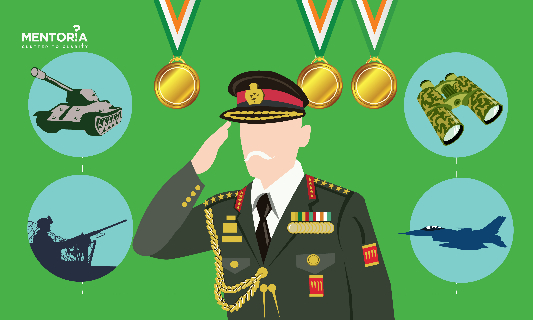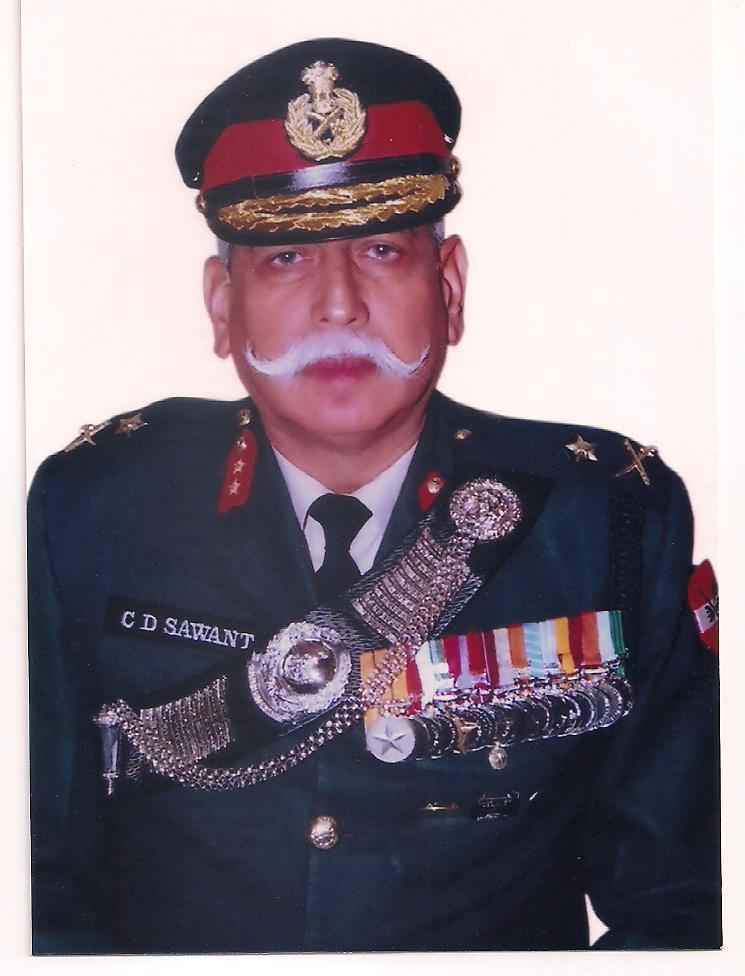Case study – All about Indian Armed Forces with Major General (Retd) CD Sawant

Jump to Section
Being in the Indian Armed Forces is considered one of the most respected jobs to have. The idea of living a disciplined life, being responsible for the security of a nation, is looked up to by one and all.
Do you too nurse the dream to join the forces?
Channel your fascination and Interest into a career you love. Take the Mentoria holistic career assessment test, to find the right career fit for you based on your interest, personality, and ability. Speak to our career counsellors here at Mentoria who can guide you from any point in your career journey.
But first, how about a glimpse into army life then? Mentoria caught up with Major General (Retd) CD Sawant, who served in the army for 37 years and has been honoured with several medals including the Ati Vishisht Seva for Training and Administrative Services in 2006.
Here are some excerpts from the interview:

Mentoria: How many branches are there in the Indian armed forces?
The Army, Navy and Air Force make up the armed forces of the country. To completely understand how each of these works we need to look at the forces as individual units.
Mentoria: Could you explain the functioning of the Army?
The army is divided into two basic branches – arms and services. Arms comprise soldiers involved in battles, whether outside or within the state. The services are involved in providing services to soldiers in the arms.
The next arms are the engineers. They are the ones who probe the mines and lay or remove them as and when required. They also provide road communication and water facilities and are also involved in making habitats for the troops.
Besides the arms and services, there is another division called the Intelligence Corp. It is responsible for all intelligence-based activities, whether it is offensive intelligence or seeking intelligence of the enemy or sending people across borders.
Discover your skills and strengths through Mentoria’s career assessment test, our premier psychometric test which helps you find your ideal career. Find out how it works here:
Mentoria: How is the navy divided and could you explain its functions?
Just like the army, the navy is divided into two branches. The executive branch consists of officers positioned above the engine area and are into the firing of guns, torpedoes, flying aircraft.
The second branch is engineers. Engineers are of two types. The ones who look after the operation of the engines are mechanical engineers. The second – electric or electronics engineers – take care of the plethora of equipment in a naval ship.
Mentoria: What about the functioning of the Air Force?
Similarly, the air force has three basic branches. One is the flying branch – which consists of pilots. Unlike the western air force, our pilots are all officers.
To be a fighter pilot, one has to be very dedicated as it takes at least ten years to become an operational pilot. The common notion is that once the pilot is qualified, he/she can fly the aircraft into a war zone. That’s not correct as the person needs to be trained for 5-6 years at least before becoming an operational fighter pilot.
The other branch is the transport wing, which consists of helicopters and aircraft that help in moving manpower and stores from one place to another.
Like the army and navy, the engineering branch of the air force provides maintenance and upkeep.
The administrative branch carries out all the administrative work in the air force either at the base or the headquarters. People here provide everything for the officers right from clothes, food to various other supplies.
Mentoria: As a Major General in the Army, could you give us an idea of the day-to-day life of an officer?
Army officers are based at stations and in the field areas. Each of them performs different duties and functions respectively.
At the station, the day begins with Physical Training (PT) at 6 am usually. In Punjab or Jammu and Kashmir, when it gets too cold, the same starts at 6:30 am. The entire unit including the commanding officer does physical training to ensure physical fitness. It is then followed by the second parade, before which the officers clean up and have their breakfast. The second parade begins at 8 am and goes on until 12:30 pm. In this period, they perform various activities like the drill parade – where the men are drilled, or the normal training, map reading, training for a particular situation and so on. As whenever we are at peace with other countries, we are training for war. The men then return to their barracks by 12:30 pm for lunch, after which they have their rest period.
The officers usually work till 1 pm and execute their administrative services in the office. At about 4:30 pm, everybody gathers for games and the officers also join in.
After the game period, we have roll calls. The Company Sergeant Major checks the health of the men and assigns duties. The men then depart for dinner during which they could perhaps watch a movie or some TV. The entire unit retires by 10 pm. The lights are out, and everyone sleeps except the people who are on sentry duty. This schedule goes on for six days a week. The 7th day is then known as administrative day, when the soldiers perform their administrative duties – getting their shoes repaired or clothes stitched or repaired, or clean weapons. This is also the day when the men get a bit of rest as well.
Moving to the field area, which is of two types. One where we are in an eyeball-to-eyeball confrontation with our bordering countries. In this scenario, say we have first light at 6:30 am then we have stand-to by 4:30 am, the entire unit is ready by then. We have a stand-to for half an hour and then the men who are supposed to stay on duty do so.
There are usually two men posted at one time; they never post sentry in singles. The duties of both are different; it is called one ‘naya’ and one ‘purana’. The concept of ‘naya’ is when the first person arrives for the sentry at 4-6 am, his buddy may be there from 3-5 am, so that person is called ‘purana’. And this is how the shifts keep changing.
Mentoria: How many threatening situations have you faced?
When I was a Company Commander, I was deployed on the Siachen glacier. In 1985, the situation was terrible. There was a lot of interference from Pakistan. So you could not move there during the day, all the activities were done at night. In the daytime, if you move, the Pakistanis would fire.
At one point, we were at a distance of 50 feet from the enemy. The men were not staying in tents, they had carved their bunkers in the ice, and they stayed there. It was a tough life. At 19,500 feet, we don’t feel hungry; we couldn’t perform our ablutions on a daily basis. We were given a special ration, which is not sufficient at times. It’s important hence to keep the morale of the men high.
Another time when I was posted in Jammu & Kashmir in 1991-94, my unit was deployed in Srinagar, and we were told to carry out counterinsurgency duties in downtown Srinagar. Three units would go together when we received any information. We would carry out a coordinated search operation. We would receive information about militants or commanders early in the morning and carry out a search in a particular area at first light. So we would gather the men from their houses while the ladies were permitted to stay in the house. Physical searches were conducted inside the homes of that particular area. The men did the screening. Sometimes we would get information from informers and we would then have to interrogate the locals. I was injured twice, once on my arm and once, my right lung was punctured. Fortunately for me, I lived, and till today I am carrying 13 splinters all over my body, going up till my left shoulder.
Every day there was something different going on. These situations continued throughout my command tenure. Every day was a new challenge.
Mentoria: What are the skills required for people to sign up for the Indian armed forces?
If you want to join the armed forces whether man or woman, you will need a spirit of adventure. You have to be willing to stay away from family. Leave is granted only once in a year.
Apart from this, people who enrol in the armed forces should be able to endure the physical stress and should have mental resilience. Until and unless the person has psychological strength, they will not be successful in the armed forces. The people who want to become officers should know how to lead from the front; if they do not have it, then they will not be able to take command.
It may seem like a tough choice to make while choosing a career in the forces, but if you love a challenge and possess the grit, this just may seem like the right path for you to follow.
Channel your fascination and Interest into a career you love. Take the Mentoria holistic career assessment test, to find the right career fit for you based on your interest, personality, and ability. Speak to our career counsellors here at Mentoria who can guide you from any point in your career journey.






